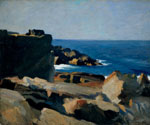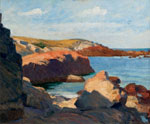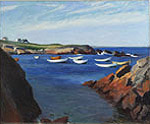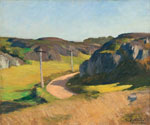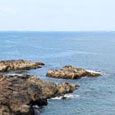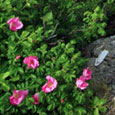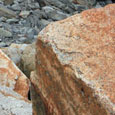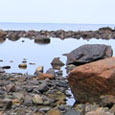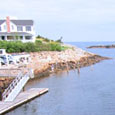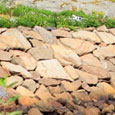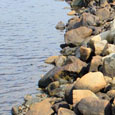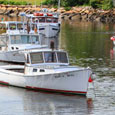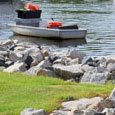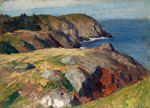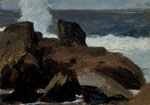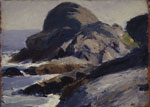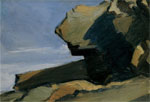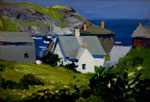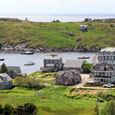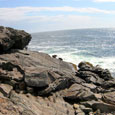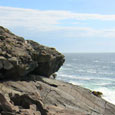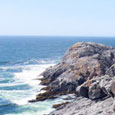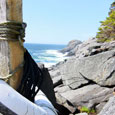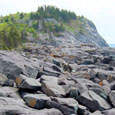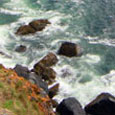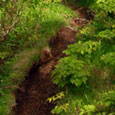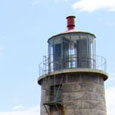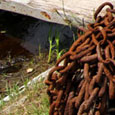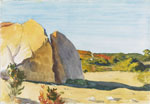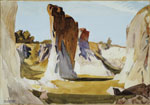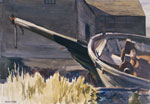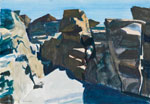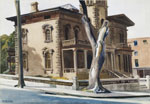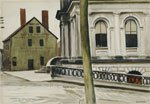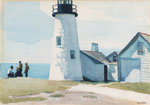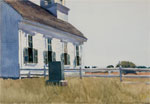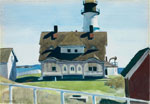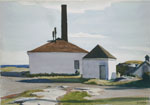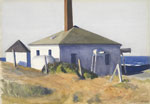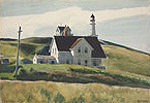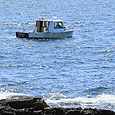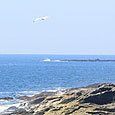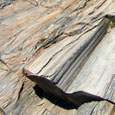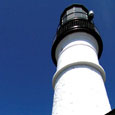When Edward Hopper first traveled to Maine in 1914, he settled in Ogunquit, home to an outpost for Boston impressionism established in 1898 by Charles Woodbury, and a more modern school of painting and sculpture founded by Hamilton Easter Field in 1911. Exposed to both schools of painting, but affiliated with neither, the artist spent this and the following summer in Ogunquit, executing seven oils. Largely bucolic coastal scenes, these were consistent with paintings he had begun to produce in Gloucester, Massachusetts, in 1912. Road in Maine, however, presents something of an anomaly; in its pathos and graphic simplicity, it prefigures Hopper's mature compositions.
It was only circa 1890 that Monhegan Island began to firmly establish itself as an artists' colony. Robert Henri first painted there in 1903, followed by his students: Rockwell Kent in 1905, George Bellows in 1911, and Edward Hopper beginning in 1916. Hopper would spend four consecutive summers there painting and drawing, concentrating primarily on distinctive rock formations such as Blackhead and Gull Rock. The resulting thirty-two paintings (effectively pochades, small plein-air oil panels whose name derives from the French word for "pocket") are among the most vibrantly colored and sculpturally worked in the artist's oeuvre.
Located approximately ninety miles north of Portland, the city of Rockland owed its prosperity to the shipbuilding and lime quarrying industries. Having unsuccessfully scouted other locations north of Bangor, Hopper arrived in the city in July of 1926 and described it in a letter to his New York dealer, Frank Rehn, as "a very fine old place with lots of good looking houses." Indeed, Rockland's Victorian homes, quarries, and ships preoccupied the artist for the next seven weeks, one of his most prolific periods working in watercolor since he had adopted the medium in 1923.
Two of Hopper's watercolors from 1927 depict Portland landmarks. A masterpiece of antebellum Italianate architecture, the home now known as Victoria Mansion was built between 1858 and 1860 for Maine native Ruggles Sylvester Morse. In characteristic fashion, Hopper assumed a challenging vantage point, eschewing totality and resisting picturesqueness.
A magnificent example of the French-influenced Second Empire style, the Portland Custom House is roughly contemporaneous with Victoria Mansion, having been erected in 1866 in recognition of the city's flourishing maritime economy. Here, Hopper once again selected a sharply oblique viewpoint, truncating the structure and devoting much of the sheet to a study of its immediate environs.
Located at the mouths of the Muscongus and Johns bays, the existing lighthouse at Pemaquid Point was built in 1835. Edward and Jo Hopper wended their way up the coast between June 27th and July 3rd, 1929, stopping at Pemaquid Point long enough for him to complete this watercolor before returning to Cape Elizabeth. Singular among Hopper's Maine work for its inclusion of a group of human figures, this watercolor cleaves to more conventional depictions of the station, while still managing to defy expectations by eliminating the very top of the tower.
By 1927, Hopper's commercial success in watercolor had furnished him with proceeds enough to purchase a car. He and his wife, Jo, enjoyed new mobility, settling in Cape Elizabeth, just south of Portland, until late September, and venturing more widely afield. In the area of Two Lights (so called because of its two lighthouses, one of which historically flashed while the other maintained a steady beam in order to help mariners navigate), Hopper painted a number of his most iconic oils and watercolors in 1927 and 1929.
